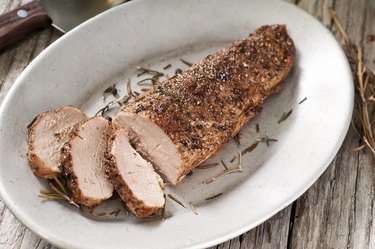
Pork butt, also known as Boston butt, actually comes from the shoulder of a pig, not its rear end. You can roast, barbecue, or shred this cut of meat to make pulled pork. Consider pork butt nutrition when choosing to eat this food.
Although it contains beneficial vitamins, minerals and protein, there are a lot of pork butt calories as well as fat. You'll want to eat this marbled meat in moderation to avoid health complications.
Video of the Day
Video of the Day
Read more: Is Pork Better Than Beef?
Pork Butt Calories and Protein
A 3-ounce-serving of pork butt, is about the size of a deck of playing cards. Pork butt, or Boston butt nutrition, includes 198 calories, according to USDA FoodData Central. Of those total calories, 92 come from the 23 grams of protein that this size serving of pork butt contains.
This dietary protein goes a long way in helping to meet the recommended daily allowances for men of 56 grams and 46 grams for women, according to the National Academies of Sciences. Protein is essential for the growth and repair of cells, muscles, skin and other organs, as well as digestion and the production of body fluids.
Don't Ignore the Fat
The marbling in pork butt contributes flavor to the meat but also adds fat content. From a 3-ounce serving of pork butt, you get about 11 grams of dietary fat. Health.gov's 2015-2020 Dietary Guidelines for Americans recommends limiting your fat intake to 20 to 35 percent of your total daily calorie intake.
For a 2,000 calorie diet, this means no more than 44 to 78 grams of fat per day. You can reduce the fat content of pork by trimming any visible fat from the meat before cooking and by draining off any fat during the cooking process.
Pork butt also contains unhealthy saturated fat as well as cholesterol, a waxy, fat-like substance. Both of these contribute to high cholesterol levels, which may increase your risk of heart disease and stroke. Of the total 11 grams of fat per serving, 4 grams come from saturated fat. The American Heart Association recommends consuming no more than 16 grams of saturated fat per day for a 2,000-calorie diet.
Read more: How to Make Oven-Baked Boneless Pork Chops
Get Your Vitamins and Minerals
Eating pork butt does provide you with some essential vitamins and minerals. It's a good source of B vitamins, selenium and zinc. B vitamins aid in energy metabolism, contribute to heart health and red blood cell production, as well as help keep the skin, nervous system and digestive system healthy.
The mineral selenium plays a role in your thyroid and reproductive health, as well as defending against free radicals and infection, according to the Office of Dietary Supplements. The zinc in pork butt supports immune function, wound healing, cell division and protein synthesis.
A 3-ounce serving of pork butt contains 51 milligrams of sodium. Not much, considering the maximum recommended daily amount for adults is 2,300 milligrams (or 1,500 milligrams if you have risk factors for heart disease), according to the American Heart Association. However, be aware that this number increases if you prep your meat with salt or other salt-containing seasonings.
- American Heart Association: "Saturated Fats"
- Office of Dietary Supplements: "Selenium"
- Office of Dietary Supplements: "Zinc"
- USDA FoodData Central: "Pork, Fresh, Shoulder, (Boston Butt), Blade (Steaks), Separable Lean Only, Cooked, Braised"
- National Academies of Sciences: "Macronutrients"
- Health.gov: "2015-2020 Dietary Guidelines for Americans"
- American Heart Association: "How Much Sodium Should I Eat per Day?"